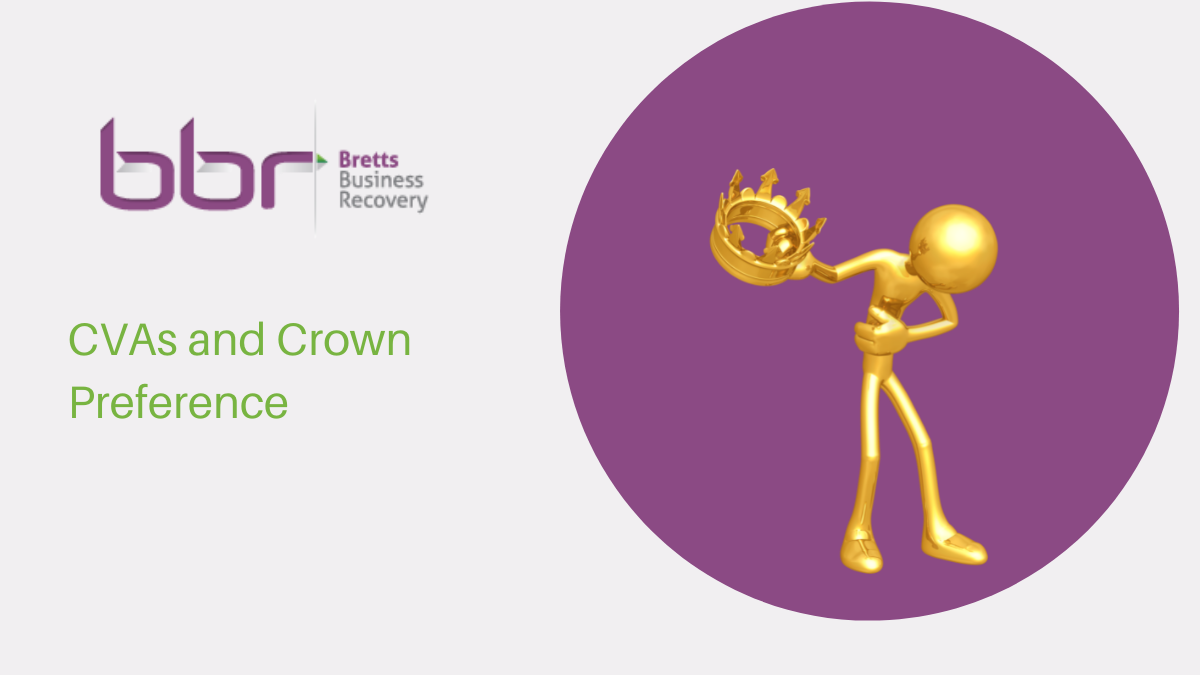CVAs and Crown Preference – has the government scored an own goal?

As the last of the COVID Restrictions are lifted , viable businesses should be allowed, where possible and with the support of their creditors, to reshape, continue profitable relationships, retain and recruit staff and generally keep the economy afloat. However, a key tool that would enable companies to achieve this, the Company Voluntary Arrangement (CVA), has essentially become redundant due to government changes to insolvency law. What is a CVA and why are the numbers falling?
The numbers of CVAs are falling
The latest insolvency stats, released on the 15th February show that the number of corporate insolvencies are now reaching, and in some cases surpassing, pre-pandemic levels. This is mainly due to the increased number of CVLs (these are markedly higher than they have been for the previous 2 years with 1,358 CVLs registered in January 2022). The number of CVAs, however, is falling – with just 13 In January 2022.
What is a CVA?
A company voluntary arrangement (CVA) is a consensual tool for business rescue which can give a viable business the chance of recovery. A CVA is a formal procedure – a legally binding agreement between the business and its creditors. It sets out how repayments of company debt should be made to creditors and can deliver a better outcome than an administration or liquidation.
With the help of an insolvency practitioner, directors will put together a feasible CVA proposal to be put to creditors. Key to the CVA’s approval by creditors include details of why it is desirable, details of the CVA contributions and the business’ plans moving forward. Once a CVA proposal is complete, the insolvency practitioner (acting as a nominee) will send it to the creditors for consideration. After 14 days creditors are asked to vote and at least 75% must agree.
It’s widely agreed that a CVA should provide for a better outcome to unsecured creditors when compared to a liquidation. If it’s rejected, it may lead to another insolvency procedure such as administration or liquidation.
Why are CVA’s falling?
A decision made by the HM Treasury in 2018 has effectively rendered CVAs nigh on impossible. In the October 2018 budget, it was announced that certain tax debts would be moved to secondary preferential status from 2020, also known as Crown Preference.
In simplistic terms, Crown Preference means that HMRC will get preferential treatment in all insolvencies commencing after December 2020. The rules as to which creditors are paid set out below:
• Secured creditors – if a creditor holds security over a particular asset such as a property or vehicle their debt will be repaid from the proceeds of the sale of that asset.
• Unsecured creditors – where there is no security creditors are paid out of “what’s left”.
• Preferential creditors (including secondary Preferential creditors) – sit between these two categories. They are unsecured creditors but are allowed to be paid first and only when they have been paid will there be anything “left” for other unsecured creditors, which would include normal trade creditors.
Prior to December 2020 the only preferential creditors were employees who were owed arrears of wages and holiday pay, but Crown Preference now means that HMRC is included in the Preferential Creditors category. Hence, the “what’s left” is significantly diminished with a knock- on effect that CVA proposals are unlikely to be accepted by creditors (where a 75% level of agreement, in value of those creditors voting, is needed)
The government’s own calculations suggested this shift to Crown Preference would increase recovery to the Treasury by an estimated £185million per year. This figure , however, pales into insignificance when compared to the sums the government has paid out in various Covid-19 support packages.
It is difficult to think of cases in which a CVA will be a realistic option for companies with significant Crown debt, leaving the majority of companies with little option but to enter administration or liquidation.
Crown Preference is essentially an own goal
The suggestion to reintroduce Crown Preference occurred prior to the pandemic, but the legislation went ahead despite the circumstances. The government could have postponed its reintroduction until the economy had returned to health, post pandemic.
Instead, the government has decided it will effectively prevent CVAs from being implemented. While this is clearly detrimental to unsecured creditors, it also has unintended negative consequences for the government as a large proportion of these businesses will have obtained bounce back or CBILS loans. If they find themselves in financial difficulty, but perceive a CVA is not possible, they will simply enter an administration or liquidation process in which all creditors will likely receive very little.
That said, CVAs are still a viable option depending on the spread of debt between the various creditors. If you’d like more information on whether a CVA could work for your business, contact the team at Bretts Business Recovery.
Contact Us